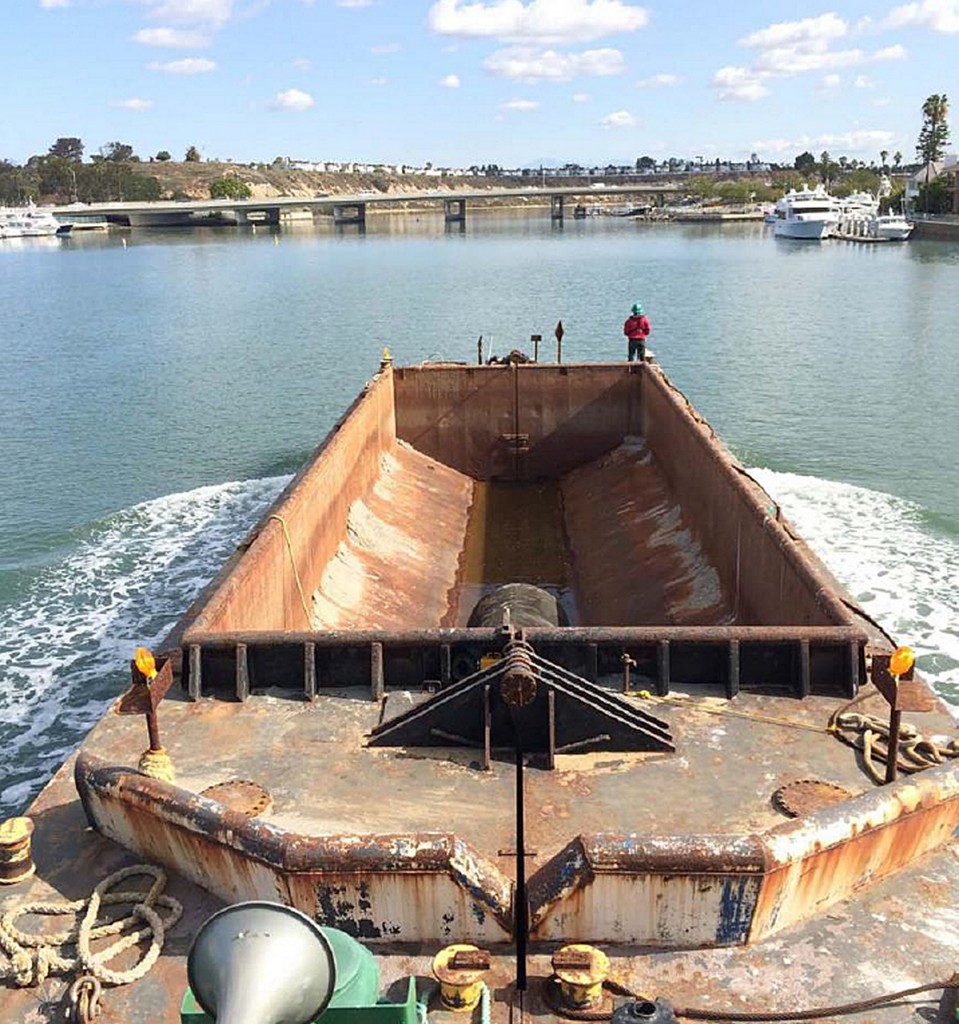Small dredging projects in Newport Harbor may soon be easier to tackle if an idea from city staff gets the wave of approval with officials.
Newport Beach Harbor Resources Manager Chris Miller recently made a presentation to the Tidelands Management Committee about the possibility of the city buying its own small refuse scow.

— Photo courtesy city of Newport Beach ©
Still in the initial idea developing and information gathering stage, Miller suggested the city purchase an ocean-going split-hull, bottom-dump scow that would be utilized for small dredging projects (mostly around residential slips).
“This proposal is to satisfy the need for our residential dredging needs,” Miller said.
A few of things to consider include the initial capital investment, which could cost between $850,000 to $1 million (depending on the capacity of the scow) to build and transport to Newport Beach. The city also needs to take into account the reoccurring costs for maintenance, Miller pointed out. Painting and taking anti-corrosion measures could be approximately $15,000 to $20,000 per year. Miller suggested the city contract a marine company to maintain the scow.
But the need is definitely there.
There are approximately 1,200 residents along the harbor and many need to dredge small amounts around their slips, but exactly how many is the “million dollar question to the equation.”
A percentage of those residents can just transfer the material onto the beach (after going through the proper process). If the grain size of the dredged material underneath the slip is determined to be suitable for beach replenishment, it’s a simple project. But it’s not that easy for everyone. If it’s fine silts and clays, it is required to be dumped at sea.
There are three parts to this type of dredging project, Miller explained: The barge, a floating platform for an excavator; a tugboat to push the dredge around and to pull the scow out to the sea; and the scow itself, the container that holds the dredged material.
The problem is that neither the city nor the small contractors have the all capital equipment required to take care of that need, Miller said.
That’s where Miller’s idea comes in.
Bigger companies often own a fleet of large scows, which can be used to work on the main channels in the harbor, but dredging in between slips for only a few hundred cubic yards does not require that size of equipment.
“You need it on a much smaller scale,” Miller noted.
For residents doing that type of project, the “big guys” aren’t going to come in to dredge such a small amount. It’s not worth it for their business, Miller noted.
“So the very nature of (this type of dredging project) attracts smaller contractors,” he said.
But, none of the small contractors who could do that kind of work own a small scow, Miller said.
“They have the barge and they can get the tug, but they just can’t find the scow,” Miller said. “The scows are virtually impossible to find…They are in extremely short supply.”
There are only three small scows on the west coast available to rent and demand for them is very high.
The city owning its own scow would help offset the high costs and schedule delays private companies currently face when trying to bring in a scow for small projects.
Currently, contractors have to “leave the line item for a scow blank because they have no idea if they can event get one,” Miller noted. If the city owned one and rented it out, contractors could then quote their customers with confidence, he added.
The idea is for the city to invest in a scow that was small enough that it could take care of the residential dredging needs and easily fit in the existing mooring field.
It should stay fairly busy the first few years with projects in Newport Harbor, but it could also be rented out regionally. It could be rented for approximately $25,000 per month.
“Ideally, I’d like to keep it within the Southern California area and keep it on a relatively short leash,” Miller said. “I want to keep it busy, but I don’t want it to disappear.”
“The number one priority is to keep it for our residents,” he added.
Most people on the Tidelands Management Committee and the citizens advisory panel were in favor, although there was skepticism. The primary concern was that it would not be very cost efficient to purchase it to only dredge a few hundred cubic yards of material, then hire a tugboat and crew, and take it out to sea to dump the material.
“But even that inefficiency is more cost effective than hiring a major dredger…to come in here with some monster piece of equipment,” Miller said. “It’s better than the alternative. It’s a better fit for the job.”
It’s important to look at it not from a business perspective, hoping for a return on the investment, Miller noted, but instead as a piece of capital equipment to help the city’s infrastructure and provide a service for residents.
“There is an intrinsic public benefit return on investment, just not in dollar and cents.” Miller said.
If it goes through the vetting process and gets approved, it could be built in four to six months.




